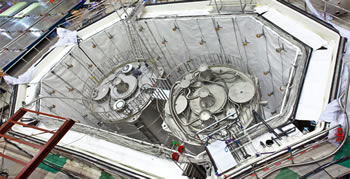Matter and Force in the Universe

Construction of the Daya Bay
Neutrino Experiment in China, a joint venture between China,
USA and a few other countries.
Berkeley Lab scientists were pathfinders to the universe as we now know it and are still in the vanguard of exploration.
The mystery of dark energy
The international Supernova Cosmology Project based at Berkeley Lab pioneered the discovery that the expansion of the universe is accelerating, revealing mysterious dark energy. The Department of Energy’s Project Office for the NASA/DOE Joint Dark Energy Mission is headquartered at Berkeley Lab, and the Lab leads the international Nearby Supernova Factory and heads the Baryon Oscillation Spectrographic Survey, a novel approach to measuring the expansion history of the universe. Lab cosmologists have joined with National Science Foundation astronomers to propose mapping the cosmos with 50 million galaxies, quasars, and hydrogen gas.
Studying the elusive neutrino
Berkeley Lab researchers were members of the teams that demonstrated that neutrinos have enough mass to allow them to change “flavors.” The Lab leads U.S. participation in the Daya Bay Reactor Neutrino Experiment, an international collaboration that will use powerful nuclear reactors in China to learn the masses of the different neutrino types. Neutrino science is the keystone of the Deep Underground Science and Engineering Laboratory (DUSEL), a multidisciplinary lab proposed for the former Homestake Gold Mine in South Dakota, where thousands of feet of rock will shield experiments from cosmic rays and background radiation. Someday DUSEL will be the deepest, biggest underground laboratory in the world. Currently the largest neutrino telescope in the world is the IceCube detector located at the South Pole, one cubic kilometer in size and buried one and a half kilometers below the surface of the Antarctic ice cap. Berkeley Lab played a major role in designing IceCube and is a member of the Collaboration now doing research with the telescope.
Nuclear science
To investigate the heart of the atomic nucleus, DOE’s new Facility for Rare Isotope Beams will include the Lab’s GRETA detector, which measures the momentum and direction of gamma rays when exotic nuclei collide and fall apart, and an injector that’s twin to Berkeley Lab’s powerful ion source, VENUS. Elsewhere, Lab scientists probe the brief era of the quark-gluon plasma in the early universe with theoretical studies and key contributions to international teams like ALICE, A Large Ion Collider Experiment at CERN’s Large Hadron Collider.
Beyond physics’ standard model
Berkeley Lab experimentalists have had long success in designing and building the apparatus for high-energy physics, like the innermost heart of the giant ATLAS experiment at CERN’s Large Hadron Collider. Lab scientists use such tools to probe why there is more matter than antimatter in the universe, the identity of dark matter, and whether there are extra dimensions of space.

